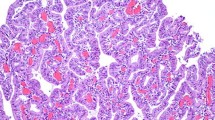Abstract
The characteristics and histogenesis of gastric-type adenocarcinomas were studied for endoscopically removed hyperplastic polyps and intramucosal cancers found in surgically resected stomachs (m-cancers). Among 421 hyperplastic polyps, 14 differentiated-type carcinomas were found (HP-cancer). Eleven (78.6%) of these lesions were gastric-type adenocarcinomas. Out of 65 m-cancers, 22 were undifferentiated-type carcinomas and 43 were differentiated-type carcinomas, the latter being classified into 10 gastric-type adenocarcinomas (23.2%) and 13 intestinal-type adenocarcinomas: the remaining 20 were of mixed gastric and intestinal type. The mean age of the gastric-type adenocarcinoma patients did not differ from that of patients with other differentiated-type carcinomas. No appreciable signs of intestinal metaplasia were noted in HP-cancer polyps. In m-cancers, the degree of intestinal metaplasia of the surrounding mucosa of gastric-type adenocarcinomas tended to be lower than in the other differentiated-type carcinomas, indicating a weak relationship between the histogenesis of gastric-type adenocarcinomas and intestinal metaplasia. Studies by PCNA (proliferating cell nuclear antigen) immunohistochemistry, showed that in over half of the gastric-type adenocarcinoma cases PCNA-positive cells tended to be localized within tumor tissues. In addition, point mutations of the c-Ki-ras gene were detected in 1 gastric-type adenocarcinoma and 2 intestinal-type adenocarcinomas, suggesting the occurence of a common genetic abnormality.
Similar content being viewed by others
Abbreviations
- PCNA:
-
proliferating cell nuclear antigen
- GOS:
-
galactose-oxidase/Schiff staining
- CPSIII:
-
paradoxical staining for stable class III mucosubstances using concanavalin A
- HP:
-
cancer adenocarcinoma arising in a gastric hyperplastic polyp
- m-cancer:
-
intramucosal carcinomas found in a surgically resected stomach
References
Daibo M, Itabashi M, Hirota H (1987) Malignant transformation of gastric hyperplastic polyps. Am J Gastroenterol 82:1016–1025
Hattori T (1985) Morphological range of hyperplastic polyps and carcinomas arising in hyperplastic polyps of the stomach. J Clin Pathol 38:622–630
Hattori T, Hosokawa Y, Fukuda M, Sugihara H, Hamada S, Takamatsu T, Nakanishi K, Tsuchihashi Y, Kitamura T, Fujita S (1984) Analysis of DNA ploidy patterns of gastric carcinomas of Japanese. Cancer 54:1591–1597
Hirohashi S, Sugimura T (1991) Genetic alterations in human gastric cancer. Cancer Cells 3:49–52
Ishiguro S (1987) Histological significance of foveolar type tubular adenocarcinoma of the stomach. Its histogenesis and relationship to undifferentiated carcinoma (in Japanese). Osaka Med J 39:507–515
Japanese Research Society for Gastric Cancer (1985) The general rules for gastric cancer study in surgery and pathology. Kanahara Shuppan, Tokyo
Kato Y, Sugano H, Wada J, Nakamura K (1978) Histogenesis of the cardiac carcinoma (adenocarcinoma) in comparison with that of the antral carcinoma (in Japanese). Stomach Intestine 13:1509–1515
Katsuyama T, Ono K, Nakayama J, Kanai M (1985) Recent advances in mucosubstance histochemistry. In: Kawai K (ed) Gastric mucus secreting cells. Excerpta Medica, Amsterdam, pp 3–18
Kihana T, Tsuda H, Hirota T, Shimosato Y, Sakamoto H, Terada M, Hirohashi S (1991) Point mutation of c-Ki-ras oncogene in gastric adenoma and adenocarcinoma with tubular differentiation. Jpn J Cancer Res 82:308–314
Lauren P (1965) The two histological main types of gastric carcinoma: diffuse and so-called intestinal-type carcinoma. Acta Pathol Microbiol Scand [A] 64:31–49
Nagayo T (1975) Histological criteria of malignant transformation of gastric polyp and its results (in Japanese). Stomach Intestine 10:301–308
Nakamura K, Sugano H, Takagi K (1968) Carcinomas of the stomach: its histogenesis and histological appearances. Gann 59:251–258
Nishimura K, Yokozaki H, Tohdo H, Sano T, Tahara E (1992) Mutation of the p53 gene and the K-ras gene in intestinal metaplasia of the stomach (in Japanese). Proc Jpn Cancer Assoc:129
Spicer SS (1965) Diamine methods for differentiating mucopolysaccharides histochemistry. J Histochem Cytochem 13:211–234
Sugano H, Nakamura K, Kato Y (1982) Pathological studies on human gastric cancer. Acta Pathol Jpn 32:329–347
Sugihara H, Hattori T, Fujita S, Hirose K, Fukuda M (1990) Regional ploidy variations in signet-ring cell carcinomas of the stomach. Cancer 65:122–129
Tatematsu M, Ichinose M, Miki K, Hasegawa R, Kato T, Ito N (1990) Gastric and intestinal phenotypic expression of human stomach cancers as revealed by pepsinogen immunohistochemistry and mucin histochemitry. Acta Pathol Jpn 40:494–504
Tatematsu M, Hasegawa R, Ogawa K, Kato T, Ichinose M, Miki K, Ito N (1992) Histogenesis of human stomach cancers based on assessment of differentiation. J Clin Gastroenterol 14 [Suppl]:S1–7
Watanabe H, Kato N, Fuchigami T, Sato T, Iwafuchi M, Ajioka Y, Ota T, Motoyama T (1992) Natural history of gastric carcinoma from analysis of microcarcinoma (in Japanese). Stomach Intestine 27:59–67
Wright DK, Manos MM (1990) Sample preparation from paraffin-embedded tissues. In Innis MA, Gelfand DH, Sninsky JJ, White TJ (eds) PCR protocols: a guide to methods and applications. Academic Press, New York, pp 153–158
Yamada Y, Kato Y (1989) Greater tendency for submucosal invasion in fundic area gastric carcinomas than those arising in the pyloric area. Cancer 63:1757–1760
Author information
Authors and Affiliations
Rights and permissions
About this article
Cite this article
Kushima, R., Hattori, T. Histogenesis and characteristics of gastric-type adenocarcinomas in the stomach. J Cancer Res Clin Oncol 120, 103–111 (1993). https://doi.org/10.1007/BF01200733
Received:
Accepted:
Issue Date:
DOI: https://doi.org/10.1007/BF01200733




